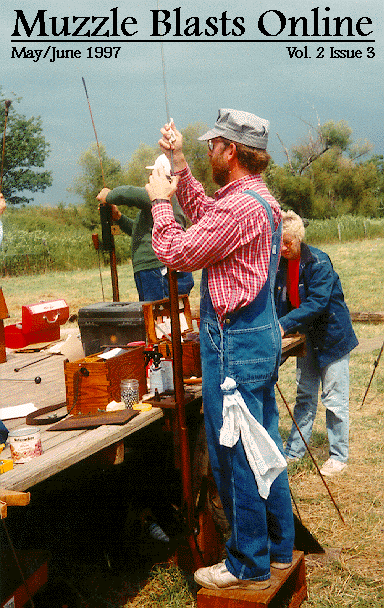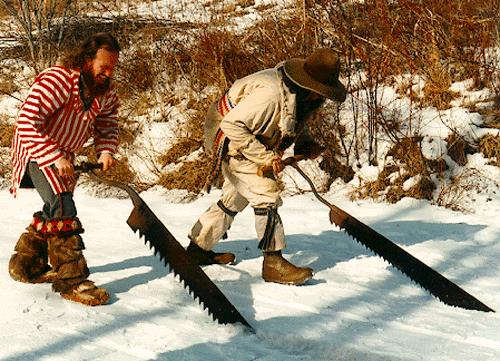|
Muzzle Blasts Online |
|
...for the muzzleloading enthusiast |
|
The muzzleblasts.com domain, subdomains, content, etc., are neither affiliated with the NMLRA nor its paper magazine Muzzle Blasts |
|
Muzzle Blasts Online |

|
|
|
|
|
|
Experiments in Self-sufficiency
Many people in New England are familiar with the spirit, if not the words, of the foregoing bit of folk wisdom. The challenge of putting on the best rendezvous possible and proving that it can be done economically has motivated the staff of the 1997 Northeastern Primitive Rendezvous to save dollars and expend sweat equity to provide some needed supplies. In the fall of 1996, our work parties cut and split about ten cords of hardwood for the event. Of course, some gas-powered beavers were used to chew the logs to length; but much of the wood has been split by hand by your booshway and his helpers. Please think of that labor as you feed your fire at the '97 Northeastern! People who prepare great quantities of firewood often quip that the wood heats twice: once as it's being worked up, and again when it's burned. We would add that by the time the wood has been felled, skidded, sawed, split, stacked, and delivered, we get to know each piece by name, and some of those names aren't too civil!
The point is, however, that with enough good help, many things are possible, not the least of which is conserving money for the rendezvous. To sweeten the work party, we held an impromptu flintlock rifle match at the end of the day. Some remaining work parties for rendezvous may be combined with overnight encampments and informal shooting and throwing events as a draw and a reward for helpers.
Our success with the wood convinced us that we could accomplish something comparable with the ice needed for our event, and do it in style: in authentic dress and with antique ice-cutting tools. To that end, we organized a work party in February on a local pond.
It was a clear, cold Saturday morning when I arrived at the site. Gibb and Eric Mach were already there. They had started to mark the ice. I was told by Gibb that the ice was about 12 inches thick. This was perfect. The other workers would be arriving soon. For most of us, this would be a first experience in cutting block ice. The blocks would be stored for use in July in our coolers at the NMLRA NEPR. We finished marking the ice to 21 inches square. Once cut, each block would weigh approximately 100 pounds.
Since we were in pre-1840 attire, our work party had the look and feel of a small primitive encampment. Workers had come form points up to two hours' drive away. Some even brought their families. We were all very grateful that they came, when later in the day we were treated to a great meal of beef stew, chili, and baked beans which they had prepared for us over a camp fire on the site.
The ice pond was in the middle of Pawlet, Vermont, home to the 1997 NMLRA Northeastern. Once people noticed what was going on, we attracted quite an audience. People turned out to take pictures of the workers clad in archaic clothing. The event was covered in the local newspaper. Some of the spectators even offered to help. It was good to know we had their interest and support.

|
|
Carl Beck and Clyde Fisher sawing ice. |
Once the blocks are on shore, a whole new set of problems arise. The blocks have to be stored in such a way that they last through the summer. This is accomplished by putting them in an ice house and packing them with sawdust. We first had to get the blocks to the ice house. approximately 200 yards away. I couldn't enlist anyone willing to carry 100 pound blocks on their shoulders for that distance. Nor was I able to get a horse and wagon for this event, but we did have a Ford pickup truck. The blocks had to be loaded onto the back of the truck by hand. Two people were required for this job due to the weight of the blocks and the height of the truck. The blocks were then transported to the ice house where they were pushed off the truck and through the door. Inside the ice house, space was limited. The ice blocks were placed inside just as a mason would lay bricks. A space was left between the blocks. This space was filled with sawdust to keep the blocks from melting together and becoming a single mass. A layer of sawdust was also placed on top of each block to accomplish the same thing when the next layer of blocks was placed on top. The walls were similarly insulated with sawdust. Once the ice house was full, the door could no longer be used, so it was sealed up. The man inside, Gibb, had to come out through an opening near the roof. The top of the ice had to be capped off with about 18 inches of sawdust so that it would be insulated from the heat once winter was over. This required vast quantities of sawdust; fortunately, that was donated to us by two different local sources.
The historical authenticity of our block ice is well established. There is no question that ice was used for food preservation prior to 1840. For the most part, it was used only in the northern climates because the source was naturally-formed winter ice. In the book Food in History by Reay Tannahill, we are told that ``As a conservation process, refrigeration had been known since the ice age, but until the problem of ice in a warmer world was solved, it lagged far behind other food preservation processes. The Chinese had discovered how to conserve natural ice for summer use as early as the eighth century B.C., by building ice houses which were kept cool by evaporation...''1 Further, Americans had mastered the technique of exporting great blocks of ``fine clear ice'' from Massachusetts to as far away as Calcutta by 1833.''2 This clearly puts ice cutting and use into our era of interest. We think our way of addressing this need adds a unique dimension to the '97 NEPR.
This process has helped us to learn what the people of bygone eras went through for some of the simple luxuries of life we take for granted today. We have provided cheap block ice for our coolers at the 1997 NMLRA NEPR . It is not suitable for drinking, but it will last far longer in our coolers than commercially made cubes . All savings from this experiment will benefit the rendezvous and the people who attend it. The business of cutting ice was fun for us, but by the end of the day we all knew that we surely did not want to do this for a living.
Our two experiments in providing for the '97 NEPR serve to validate points which some other events might take to heart: work parties can be fun for the staff, generate some early interest among the public, and provide for free necessary services which people sometimes assume must be bought at considerable expense.
I would like to thank all who helped with these projects. They include the Youngs, who donated the trees and lots of labor for our firewood. Special thanks go also to Gibb and Eric Mach, owner's of Mach's General Store, the ice house, the pond, the tools and the know-how to conduct a successful ice cutting event. To Bill McKenzie, owner of Bear paw Lumber and, Jim Ross, owner of Ross's Lumber, we are indebted for the donation of sawdust required for this project.
Until we meet at the Northeastern, keep your powder dry and your perishables cold!
NOTES
BIBLIOGRAPHY